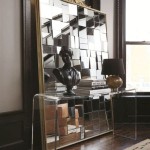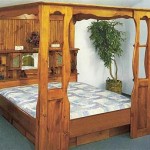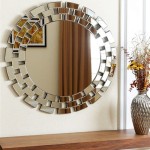French Rococo Mirrors: Elegance and Opulence Reflected
French Rococo mirrors represent a pinnacle of decorative art, embodying the luxurious and playful spirit of the 18th century. Their intricate designs and elaborate ornamentation served not only as functional reflective surfaces but also as significant statements of wealth and taste within aristocratic French society. These mirrors became integral components of the overall Rococo aesthetic, contributing to the light, airy, and ornate interiors that characterized the era.
Asymmetrical Designs and the C-Scroll
A defining characteristic of French Rococo mirrors is their departure from the strict symmetry of earlier Baroque styles. Asymmetry reigns supreme, with designs featuring dynamic curves, scrolls, and naturalistic motifs. The C-scroll, or rocaille, is a recurring element, lending its name to the entire Rococo movement. These asymmetrical designs, often incorporating shell, floral, and foliate motifs, create a sense of movement and dynamism, reflecting the Rococo's embrace of nature and organic forms.
Gilding and the Use of Gold
Gilding played a crucial role in achieving the opulent look of French Rococo mirrors. Artisans applied thin sheets of gold leaf to the wooden frames, creating a radiant and luxurious surface. The gold not only enhanced the visual impact of the mirror but also served as a symbol of wealth and status. The extensive use of gold contributed significantly to the overall light and airy ambiance of Rococo interiors, reflecting and amplifying the candlelight that illuminated these spaces.
Integration of Putti, Floral, and Foliate Motifs
Beyond the ubiquitous C-scroll, French Rococo mirrors frequently featured a variety of decorative motifs. Putti, or cherubic figures, often appeared within the intricate framework, adding a playful and whimsical touch. Floral and foliate elements, including acanthus leaves, roses, and other blossoms, intertwined with the overall design, further emphasizing the connection to nature and creating a sense of overflowing abundance.
The Trumeau Mirror: A Statement Piece
The trumeau mirror emerged as a prominent form during the Rococo period. This type of mirror was designed to fit above a fireplace mantel or between two windows, often extending from floor to ceiling. Trumeau mirrors became focal points within Rococo interiors, showcasing the full artistry and craftsmanship of the period. Their large size allowed for even more elaborate decoration and contributed significantly to the grandeur of the room.
Emphasis on Craftsmanship and Hand-Carving
The creation of French Rococo mirrors required highly skilled artisans. The intricate carvings, delicate gilding, and precise assembly demanded meticulous attention to detail. Hand-carving was essential, allowing for the creation of unique and personalized pieces. The value placed on craftsmanship contributed to the high cost of these mirrors, further solidifying their status as luxury items.
The Role of Mirrors in Rococo Interiors
French Rococo mirrors played a significant role beyond their decorative function. They were strategically placed to maximize light and create an illusion of spaciousness within the often smaller rooms of Parisian townhouses. The reflective surfaces bounced candlelight around the room, enhancing the overall brightness and creating a sense of depth. This skillful use of mirrors contributed to the light, airy, and theatrical atmosphere that characterized the Rococo aesthetic.
Variations in Shape and Size
While many Rococo mirrors featured the characteristic rectangular shape of the trumeau, a variety of other forms also existed. Oval, circular, and even irregular shapes were incorporated into the designs, reflecting the Rococo's embrace of fluidity and asymmetry. Small hand mirrors, often elaborately decorated, provided a portable version of the Rococo aesthetic. The variation in size and shape allowed for the integration of these mirrors into diverse settings, from grand salons to intimate boudoirs.
Influence and Legacy
The influence of French Rococo mirrors extends beyond the 18th century. Their elegant designs and intricate ornamentation continue to inspire contemporary designers and decorators. Reproductions and adaptations of Rococo mirror styles remain popular, attesting to the enduring appeal of this opulent and whimsical style. The legacy of these mirrors serves as a reminder of the artistry and craftsmanship that flourished during the Rococo period, and their continued presence in interiors worldwide reflects their timeless elegance.

19th Century Rococo Style Carved And Giltwood French Mirror Legacy Antiques

Large French Rococo Louis Xv Style S And Floral Carved 65 Gold Wall Mirror For At 1stdibs

French Rococo Carved Giltwood Palatial Oval Mirror Vintage Gold Fireplace Mantel Mirrors

A French Rococo Mirror

French Mirror 1 In Stock 7 Feet Tall Baroque Rococo Antique Vintage Gold Leaf Furniture Interior Design

Mid 19th Century Gilt Broe French Rococo Style Mirror Harrington Antiques

A French Rococo Style Mirror In Gilded Broe Frame Mid 19th Century 81 X 55cm

Vintage French Italian Rococo Louis Xv Style Gold Wall Mantle Mirror W Figures Israel

Vintage French Rococo Decorative Gold Oval Wall Mirror Firebird Furniture
Imw4151 Beautiful Antique French Rococo Style Mirror








